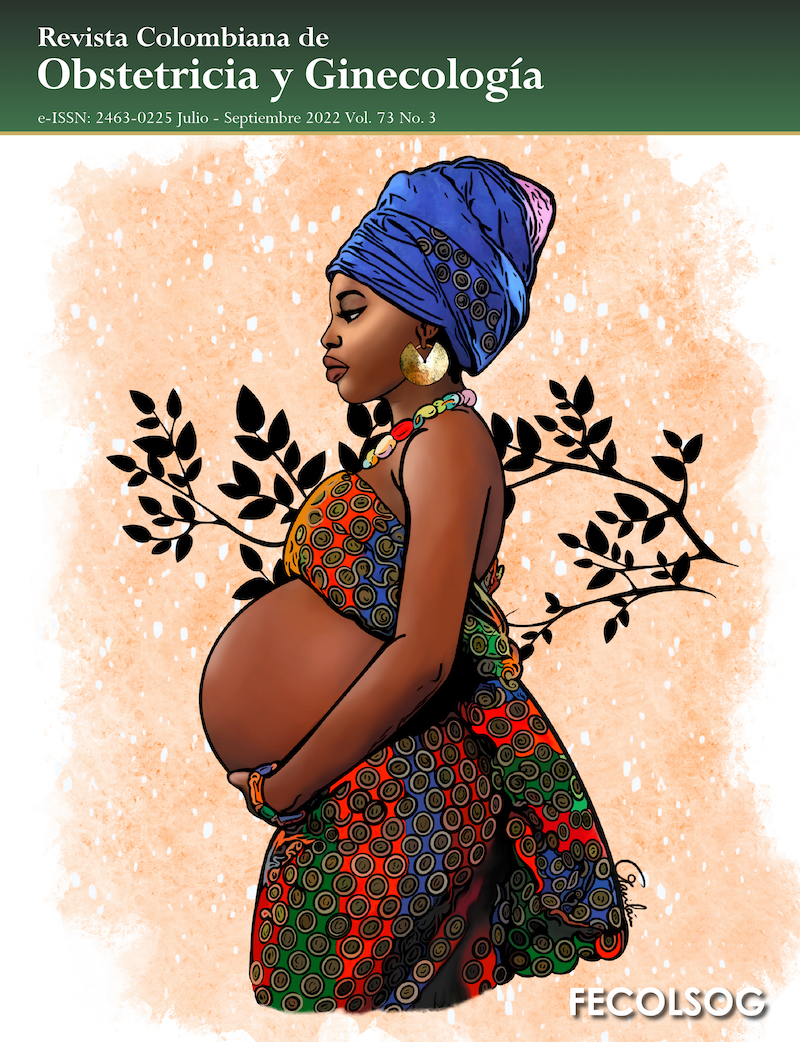Agreement between two scales used for assessing risk classification for thromboembolic events and the requirement of postpartum pharmacological prophylaxis
DOI:
https://doi.org/10.18597/rcog.3831Keywords:
Pre-exposure prophylaxis, obstetrics, venous thromboembolism, postpartum periodAbstract
Objectives: To determine agreement in assessing the need for postpartum pharmacological prophylaxis between the scale of the Royal College of Obstetricians and Gynaecologists and the Colombian guideline scale in a Level IV institution in Bogota, Colombia.
Material and methods: Diagnostic agreement study assembled on a cross-sectional study. The included population consisted of pregnant women with 24 or more weeks of pregnancy admitted between March 1 and April 30 of 2021 to a high complexity private institution in Bogotá, Colombia, for labor induction, in active labor, for elective cesarean section, or who required urgent cesarean section. Convenience sampling was used. Measured variables included demographics, risk factors, risk classification and pharmacological prophylaxis according to the two scales. The prevalence of risk factors for each scale was estimated and agreement regarding prophylaxis indication between the two scales was measured using the weighted kappa value.
Results: Overall, 320 patients were included. According to the scale of the Royal College Obstetricians and Gynaecologists, 54.7 % patients were classified as low risk, 42.5 % as intermediate risk and 2.8 % as high risk. The Colombian scale classified 80 % of patients as low risk, 17.2 % as intermediate risk, 2.2 % as high risk, and 0.6 % as very high risk. The weighted kappa value for agreement regarding the indication was 0.47 (95 % CI: 0.38-0.56).
Conclusions: Agreement between the two scales to determine the need for postpartum pharmacological prophylaxis is moderate. Risk classification criteria for the Colombian scale should be validated in a second cohort. Moreover, the predictive ability of the Colombian guideline tool should be assessed at different cut-off points in terms of the consequences of false positive and false negative results.
Author Biographies
Jaime Luis Silva-Herrera, Hospital Universitario San Ignacio, Bogotá (Colombia).
Hospital Universitario San Ignacio, Bogotá (Colombia), Clínica del Country, Bogotá (Colombia).
Diana Patricia Polanía-Reyes, Clínica del Country, Bogotá (Colombia).
Clínica del Country, Bogotá (Colombia).
Adriana Carolina Aya-Porto, Centro de Investigación-Clínica del Country, Bogotá (Colombia).
Centro de Investigación-Clínica del Country, Bogotá (Colombia).
Angélica María Russi-Santamaría, Centro de Investigación-Clínica del Country, Bogotá (Colombia).
Centro de Investigación-Clínica del Country, Bogotá (Colombia).
Natalia Suarez-Pareja, Centro de Investigación-Clínica del Country, Bogotá (Colombia).
Centro de Investigación-Clínica del Country, Bogotá (Colombia).
References
Instituto Nacional de Salud. Morbilidad materna Extrema. Revisión Temática. Boletín epidemiológico Sem. 2020; Semana epi: 53. https://doi.org/10.33610/23576189.2020.53
Meng K, Hu X, Peng X, Zhang Z. Incidence of venous thromboembolism during pregnancy and the puerperium: a systematic review and meta-analysis. J Matern Fetal Neonatal Med. 2015;28(3):245-53. https://doi.org/10.3109/14767058.2014.913130
Sultan AA, West J, Tata LJ, Fleming KM, Nelson-Piercy C, Grainge MJ. Risk of first venous thromboembolism in and around pregnancy: a population-based cohort study. Br J Haematol. 2012;156(3):366-73. https://doi.org/10.1111/j.1365-2141.2011.08956.x.
Gray G, Nelson-Piercy C. Thromboembolic disorders in obstetrics. Best Pract Res Cl Ob. 2012;26: 53–64. https://doi.org/10.1016/j.bpobgyn.2011.10.003
Royal College of Obstetrician and Gynaecologist. Reducing the risk of venous thromboembolism during pregnancy and the puerperium. Green Top Guideline No 37ª - April 2015
Marik PE. Venous Thromboembolism in Pregnancy. Clin Chest Med. 2010; 31(4):731-40. https://doi.org/10.1016/j.ccm.2010.06.004.
American College of Obstetricians and Gynecologists' Committee on Practice Bulletins—Obstetrics. ACOG Practice Bulletin No. 196: Thromboembolism in Pregnancy. Obstet Gynecol. 2018;132(1):e1-e17. https://doi.org/10.1097/AOG.0000000000002706
Asociación Bogotana de Obstetricia y Ginecología GD de la G de PC, Grillo-Ardila CF, Mogollón-Mariño AC, Amaya-Guío J, Molano-Franco D, Correa LP. Guía de práctica clínica para la prevención de eventos tromboembólicos venosos durante la gestación, el parto o el puerperio. Rev Colomb Obstet Ginecol. 2017; 68(4):286. https://doi.org/10.18597/rcog.3084
Palmerola KL, D’Alton ME, Brock CO, Friedman AM. A comparison of recommendations for pharmacologic thromboembolism prophylaxis after caesarean delivery from three major guidelines. BJOG An Int J Obstet Gynaecol. 2016; 123(13):2157–62. https://doi.org/10.1111/1471-0528.13706
Landis JR, Koch GG. The measurement of observer agreement for categorical data. Biometrics. 1977;33(1):159-74.
Lok WY, Kong CW, To WWK. A local risk score model for venous thromboembolism prophylaxis for caesarean section in Chinese women and comparison with international guidelines. Taiwan J Obstet Gynecol. 2019 Jul;58(4):520-525. https://doi.org/10.1016/j.tjog.2019.05.016
Silva-Herrera JL, Duque-Giraldo MA, Torres-Chaparro C, Sanín-Blair JE, Niño-Peña ML,Higuita-Rendón AM. Profilaxis tromboembólica en pacientes posparto. Estudio de corte transversal en tres instituciones en Colombia. Rev Colomb Obstet Ginecol. 2016; 67(1):20. https://doi.org/10.18597/rcog.364
Liu S, Liston RM, Joseph KS, Heaman M, Sauve R, Kramer MS. Maternal Health Study Group of the Canadian Perinatal Surveillance System. Maternal mortality and sever morbidity associated with low-risk planned cesarean delivery versus planned vaginal delivery at term. CMAJ 2007; 176:455–60. https://doi.org/10.1503/cmaj.060870
Abdul Sultan A, Grainge MJ, West J, Fleming KM, Nelson-Piercy C, Tata LJ. Impact of risk factors on the timing of first puerperium venous thromboembolism: a population-based cohort study from England. Blood. 2014;124(18):2872-80. https://doi.org/10.1182/blood-2014-05-572834
Liu S, Rouleau J, Joseph KS, Sauve R, Liston RM, Young D, et al. Maternal Health Study Group of the Canadian Perinatal Surveillance System. Epidemiology of pregnancy-associated venous thromboembolism: a population-based study in Canada. J Obstet Gynaecol Can. 2009; 31:611–20. https://doi.org/10.1016/S1701-2163(16)34240-2
Callaghan WM, Creanga AA, Kuklina EV. Severe Maternal Morbidity Among Delivery and Puerperium Hospitalizations in the United States: Obstet Gynecol. 2012;120(5):1029-36. https://doi.org/10.1097/AOG.0b013e31826d60c5
How to Cite
Downloads
Downloads
Published
Issue
Section
License

This work is licensed under a Creative Commons Attribution-NonCommercial-NoDerivatives 4.0 International License.
| Article metrics | |
|---|---|
| Abstract views | |
| Galley vies | |
| PDF Views | |
| HTML views | |
| Other views | |
















